| Srl | Item |
| 1 |
ID:
089603
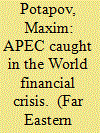

|
|
|
|
|
| Publication |
2009.
|
| Summary/Abstract |
The author reviews the results of the APEC meeting in Lima, Peru. The significance of the forum is examined in the context of the current world financial crisis and prospects for commercial and economic liberalization and integration in the region.
|
|
|
|
|
|
|
|
|
|
|
|
|
|
|
|
| 2 |
ID:
054877
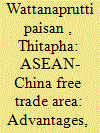

|
|
|
| 3 |
ID:
051986
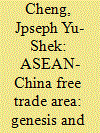

|
|
|
|
|
| Publication |
June 2004.
|
| Summary/Abstract |
The Asia-Pacific region's vulnerabilities to the consequences of globalisation were vividly revealed by its financial crisis in 1997-98. ASEAN states considered the US and APEC less than helpful during the crisis, and they found the conditionalities imposed by the IMF unpalatable. But ASEAN as a regional organisation has been much weakened, and it has been working hard to revive its influence. The 'ASEAN plus 3' approach has been perceived as an important means to strengthen ASEAN's status and relevance. The ASEAN-China Free Trade Area is undoubtedly an outstanding achievement of this approach; but ASEAN has been trying to keep its options open. On the other hand, China has been concerned with the danger of a deterioration in Sino-American relations and the increasing distrust between Tokyo and Beijing. Improvement of China-ASEAN relations therefore assumes increasing significance in China's regional policy; and enhancing mutual interests and interdependence is the best way to erode the ASEAN states' perception of the 'China threat'. But China must not neglect the interests of Japan and South Korea or underestimate ASEAN's resistance to the exclusion of the US and its desire to maintain a balance of power in the region. The ASEAN-China Free Trade Area, hopefully, should also facilitate the narrowing of the gap between the more developed and the developing ASEAN members, as well as that between the more prosperous coastal provinces and the poor interior provinces in China. In many ways, the establishment of the ASEAN-China Free Trade Area represents a challenge to what can be achieved in the mutual engagement process.
|
|
|
|
|
|
|
|
|
|
|
|
|
|
|
|
| 4 |
ID:
066140
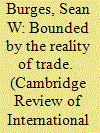

|
|
|
| 5 |
ID:
073350
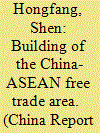

|
|
|
|
|
| Publication |
2006.
|
| Summary/Abstract |
This article examines Philippine perspectives on the CAFTA and explores the reasons why Philippine official and business circles are not willing to accept the CAFTA concept. It makes a brief assessment of Sino-Philippine economic relations in the context of the CAFTA, and also illustrates the changing attitudes of Philippine official and business sectors toward the CAFTA.
|
|
|
|
|
|
|
|
|
|
|
|
|
|
|
|
| 6 |
ID:
059543
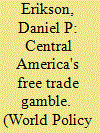

|
|
|
|
|
| Publication |
Winter 2004-05.
|
|
|
|
|
|
|
|
|
|
|
|
|
|
|
|
| 7 |
ID:
054090
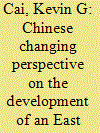

|
|
|
| 8 |
ID:
166982
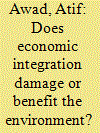

|
|
|
|
|
| Summary/Abstract |
The leaders of African nations have committed to the establishment of the Continental Free Trade Area (CFTA) over the coming years. Improved links among the African nations, via increased intra-regional trade, have been considered as an essential mechanism to produce desired growth run-overs and to support regional economic improvement. However, remarkable theoretical and empirical evidence has shown that increased trade might damage the environment and therefore may hinder the effort towards sustainable development and poverty reduction on the continent. The present paper seeks to investigate and test the impact of intra-Africa trade using two measurements of environmental pollutants, namely CO2 and MP10 whilst integrating economic growth, and energy consumption. The study used a panel dataset regarding 46 African countries over the period 1990–2017. To carry out the empirical analysis, the latest panel estimation techniques were employed. More specifically, and for the urbaneness purpose, we employed a parametric technique, which is dynamic OLS, and a non-parametric approach which is FMOLS. The results of both methods suggested that intra-Africa trade improved environmental quality on the continent. In addition, the results confirmed the presence of the Environmental Kuznets Curve (EKC) hypothesis. The findings also indicated that whilst the consumption of energy played a vital role in the deterioration of the environment, its impact remained marginal. Overall the results implied that intra-regional trade and the environment quality were mutually supportive in Africa.
|
|
|
|
|
|
|
|
|
|
|
|
|
|
|
|
| 9 |
ID:
154062
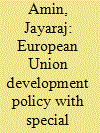

|
|
|
|
|
| Summary/Abstract |
The development cooperation policy of the European Union (EU) ever since its inception has witnessed significant changes in its nature and direction. EU’s development policy framework had its origin in the “association” of the overseas countries and territories (former colonies of founding members) with the fledgling EEC for economic and social development at the insistence of French in the negotiations in 1956 leading to Rome Treaty.
|
|
|
|
|
|
|
|
|
|
|
|
|
|
|
|
| 10 |
ID:
068255
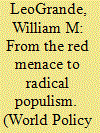

|
|
|
| 11 |
ID:
089273
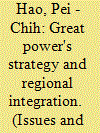

|
|
|
| 12 |
ID:
056978
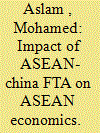

|
|
|
| 13 |
ID:
079064
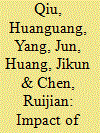

|
|
|
|
|
| Publication |
2007.
|
| Summary/Abstract |
This study aims to examine the impact of the China-ASEAN Free Trade Area (CAFTA) on China's international agricultural trade and its regional agricultural development, using the Global Trade Analysis Project model and the China Agricultural Decision Support System. Our analysis showed that: (i) CAFTA will improve resource allocation efficiencies for both China and ASEAN and will promote bilateral agricultural trade and, hence, will have positive effects on the economic development of both sides; (ii) CAFTA will accelerate China's export of the agricultural commodities in which it has comparative advantages, such as vegetables, wheat and horticultural products, but at the same time bring about a large increase in imports of commodities such as vegetable oil and sugar; and (iii) CAFTA will have significantly varying impacts on China's regional agricultural development because of large differences in the agricultural production structure in each region. Our results indicate that agriculture in the northern, northeastern and eastern regions of China will benefit from CAFTA, whereas agriculture development in southern China will suffer. Those regional specific impacts are quite different from the effects brought by multilateral free trade treaties, such as those of the WTO, which usually have positive effects on south China but negative impacts on the northern and western parts of China
|
|
|
|
|
|
|
|
|
|
|
|
|
|
|
|
| 14 |
ID:
092431
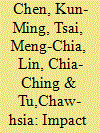

|
|
|
|
|
| Publication |
2009.
|
| Summary/Abstract |
This paper applies a computable general equilibrium model to investigate the potential economic effects of trade liberalization across the Taiwan Strait. Our simulation results reveal that cross-Strait trade liberalization will have significant positive impacts on external trade, domestic investment and real GDP for the economies in this area in general and in Taiwan in particular. Furthermore, the negative impact from the formation of a free trade arrangement between Taiwan and Chinese Mainland on Hong Kong seems to be rather small. These results suggest that cross-Strait trade liberalization is very likely to bring about a win-win situation for the economies in this area.
|
|
|
|
|
|
|
|
|
|
|
|
|
|
|
|
| 15 |
ID:
127628
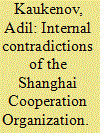

|
|
|
|
|
| Publication |
2013.
|
| Summary/Abstract |
In recent years, China has perceptibly strengthened its position in Central Asia largely due to the multisided cooperation format embodied by the Shanghai Cooperation Organization (SCO). From Beijing's perspective, it is not only a key organization, but essentially a regional integration project. Moreover, Central Asia's development is closely tied to the development of Xinjiang, in which the Chinese leadership is making large investments in order to eliminate the separatist moods in this unsettled region. Nevertheless, the SCO has substantial systemic contradictions that the new CPR leadership headed by Xi Jinping is trying to overcome.
The West initially had a passive attitude toward the SCO. At that time, the North Atlantic Alliance regarded the Shanghai Five as a structure that did not pose a threat to the West's interests; on the contrary, it showed a decrease in Moscow's previously dominating role in Central Asia due to the appearance of a new player-China. Later, however, as China's cooperation with the region's countries, primarily with Kazakhstan in the oil sector, started to mount, Washington began having a different opinion.
The SCO's prospects for the Central Asian countries are determined by this organization's capability to maintain the balance of power in the region. Moreover, the region's countries are interested in acquiring additional investments and capital (Chinese) through the organization's channels. An analysis of the main areas of development of this structure based on the interests of the Central Asian countries is required for a more precise definition of the SCO's prospects for the region's countries.
|
|
|
|
|
|
|
|
|
|
|
|
|
|
|
|
| 16 |
ID:
067774
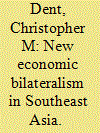

|
|
|
| 17 |
ID:
080470
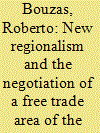

|
|
|
|
|
| Publication |
2007.
|
| Summary/Abstract |
This article examines the pros and cons of the "new regionalism," with the negotiations for a Free Trade Area of the Americas (FTAA) taken as a landmark. It summarizes the main features of the "new regionalism" and reviews some of the challenges and opportunities opened by North-South preferential trade agreements (a category that includes many of the new vintage of such agreements). The article also evaluates the record of the FTAA negotiations, emphasizing recent trends and prospects, especially the foundations of the current stalemate
|
|
|
|
|
|
|
|
|
|
|
|
|
|
|
|
| 18 |
ID:
105896
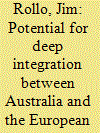

|
|
|
|
|
| Publication |
2011.
|
| Summary/Abstract |
This paper aims to identify evidence of any potential costs of preferential liberalisation of trade in goods between the EU and Australia, notably trade diversion; move beyond Australia's exports of commodities to the EU to look for evidence of competitiveness in high-value-added manufactures; and identify evidence of the potential for deep integration that might be promoted by a formal FTA using the Sussex Framework for analysing economic integration and TradeSift software. It concludes that costs of trade Diversion are unlikely to be large; that there is the potential for a mutual recognition agreement to encourage deep integration in areas of high value added manufactures; but that it might require a formal free trade agreement to give the institutional framework to allow mutual recognition to work.
|
|
|
|
|
|
|
|
|
|
|
|
|
|
|
|
| 19 |
ID:
090112


|
|
|
|
|
| Publication |
2009.
|
| Summary/Abstract |
The current global financial and economic crisis is giving new life to initiatives that promote closer economic integration among East Asian countries. A significant example is the ASEAN-China Free Trade Area (ACFTA), which is set to come into effect around 2010. ACFTA aims to boost trade between two economies that are partners as well as competitors: ASEAN and China. In the present paper, we use insights from customs union theory in a qualitative analysis considering whether ACFTA would benefit both sides. We also apply a computable general equilibrium model to perform a quantitative analysis of the same issue. Both our qualitative and quantitative analyses provide grounds for guarded optimism regarding ACFTA's prospects as a vehicle for strengthening the economic partnership between ASEAN and China.
|
|
|
|
|
|
|
|
|
|
|
|
|
|
|
|
| 20 |
ID:
023615
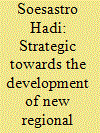

|
|
|
|
|
| Publication |
2002.
|
| Description |
387-395
|
|
|
|
|
|
|
|
|
|
|
|
|
|
|
|